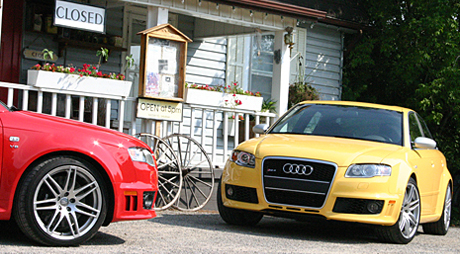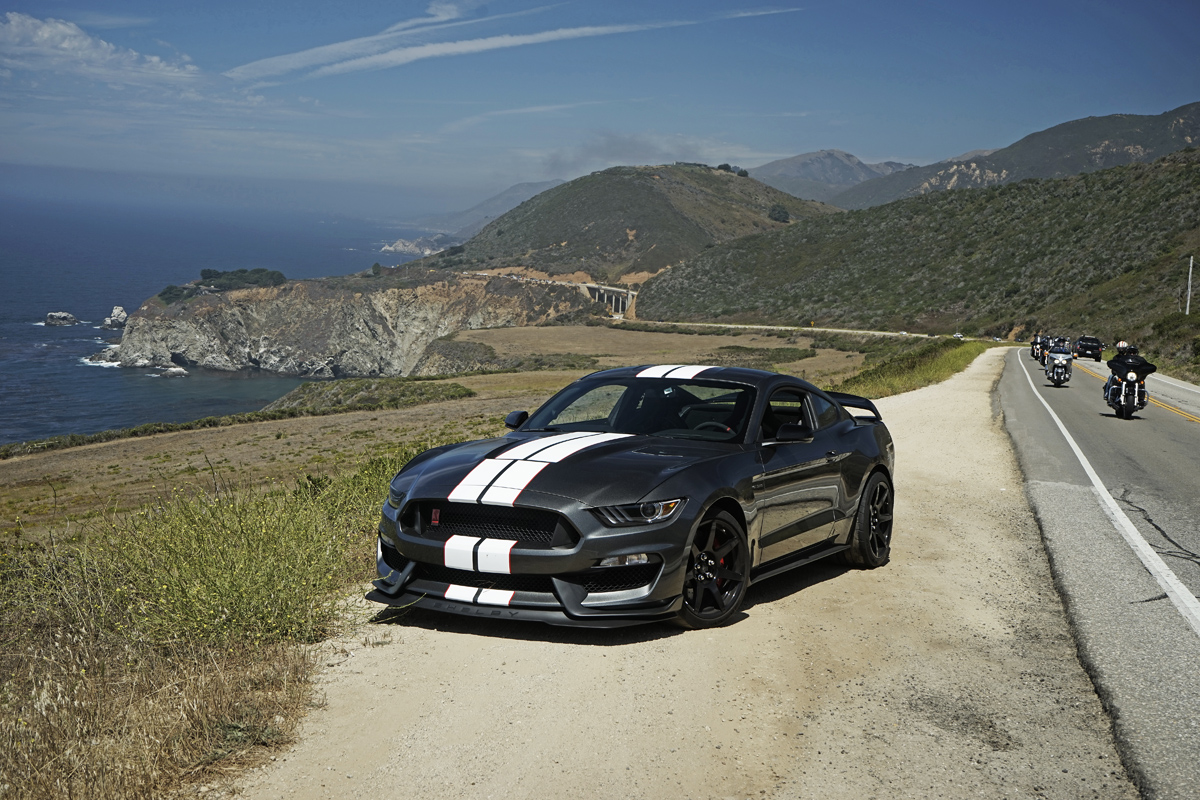The Total Audi
This week I got to spend a few hours behind the wheel of the 2007 Audi RS4, a vehicle Audi professes to be the best of both performance and prestige worlds.

‘RS’ is the badge Audi gives to its best-performing cars and enthusiasts of the brand know it well. The top-line abbreviation’s legacy goes back a dozen years to the 1994 RS2 model featuring a 315-hp five-cylinder turbo engine. Followed in 2000 by the 380-hp bi-turbo V6 RS4 as well as the 2002 RS6 Avant, which has a 450-hp bi-turbo V8, none of these first three generations ever made it to North America. All that changed, however, in 2003/04 when Audi began offering the RS6 sedan to U.S. and Canadian customers with a more powerful V8 and 30 extra ponies.
During its dozen year run, the five-car RS lineup has matured into a genuine flagship product for Audi that’s lauded by owners and coveted by dreamers. The newest family member is the 2007 Audi RS4, perhaps the most anticipated of them all.
Whereas Audi AG is responsible for series production of everything from the diminutive A3 to the large and luxurious S8, the RS line is actually built by Audi’s performance extension, quattro GmbH. The approach is similar to that of Mercedes-Benz and AMG, but unlike AMG, quattro has always been under the automaker’s corporate umbrella (since being founded 1983). Its mission is simple: to advance and complement the Audi brand by developing high-performance products such as the A4 S-Line and other exclusive lifestyle accessories.
Since 1996, quattro GmbH has been registered as a manufacturer of high-performance vehicles with its own development and production areas in the Audi plants in Neckarsulm and Ingolstadt, Germany.
After a brief presentation by Karsten Ruwoldt, Audi Canada, my RS4 drive begins at Pfaff Audi in Vaughn–a newly-constructed 70,000 sq-ft totally modern dealership that embodies Audi’s corporate image wholeheartedly. It is the largest Audi dealer in Canada and quite a marvel by itself. On this day, however, it takes a back seat to the yellow RS4 with my name on it.
Before I even get the chance, Douglas Clark, Director of Communications and PR, hops into to my car to show us the effect of the “S-button” found on the upper dash. He pumps the accelerator a few times so all can hear the 4.2L V8 engine’s beautiful exhaust note. It’s smooth, deep and sporty with a hint of aggressiveness. He then presses the button to engage “Sport” mode and does it again. This time, it sounds much throatier and more aggressive with a definite change in pitch. What’s actually happening is a small valve in the exhaust system is opening up to allow for a louder intake and exhaust sound. It doesn’t add more horsepower to the cars already powerful 420 hp naturally-aspirated engine, but it does automatically re-map the throttle position sensor for quicker response via a sport-tuned electronic throttle control. We hadn’t even left the parking lot and were close to bursting from the anticipation.
On the road, the all-aluminum 4.2L DOHC V8 FSI, which stands for “Fuel Straight Injection,” direct injection engine commands the road with 420 hp at 7,800 rpm and 317 lb.-ft. of torque at 5,500 rpm. The high-compression powerplant features a modified cylinder head with beefed-up pistons, connecting rods and crankshaft that help net 80 hp and 15 lb.-ft. of torque more than the S4. Its FSI technology, which proved itself on Audi’s Le Mans-winning R8 racecar, ensures optimal combustion at 12.5:1, and along with an improved cooling system, redesigned intake with single butterfly throttle, plus a RS 4-specific dual exhaust system, the effective powerband is very wide. Delivery of that power is very smooth too (although shifting from first to second gear is a bit jerky until you get used to it).
Altogether, Audi says this high-revving engine (8,250 rpm limit) makes over 100 hp/L with an outstanding power-to-weight ratio of 3.9 kg (8.7 lb/hp). The only transmission choice is really sweet–a silent and smooth beefed-up six-speed manual–and can ascertain zero-to-60 mph times in under five seconds (4.8). While top speed is electronically limited at 250 km/h (155 mph), it’s aplenty for North American roads. The amazing thing is that horsepower and torque remain very steady or constant whether driving fast or slow.
The RS 4 handles like a dream thanks to Audi’s quattro all-wheel drive system with the latest Torsen centre differential and dynamic torque split. Under normal conditions, weight distribution is 40/60 front/rear (rear biased), but up to 100 percent of the power can be sent to either the front or rear axle when needed. In the front is an independent four-link suspension arrangement with a virtual steering axis and anti-roll bar. A double wishbone configuration with anti-roll bar takes care of business in the rear.
RS4 uses a Dynamic Ride Control (DRC) system that sees the shock absorbers diagonally-connected (front right to rear left and vice versa) and sharing a central reservoir. Besides offering razor-like precision under a wide array of road surfaces and conditions, the benefits of this fully mechanical system include substantially reduced pitch while braking and body roll when taking corners quickly. This makes it superior to the S4’s; and, in conjunction with the DRC, ESP 8.0 with brake disc wiping comes standard on the RS 4. However, unlike certain other manufacturers who do not seem to trust their customers to make up their own minds, Audi has made this traction control system completely defeatable. Push and release the ESP button once and you’ve turned off the ESP. Push and release once followed by a push-and-hold for a second or two and, voilà , the traction control is completely gone.
The RS4 is NOT sprung like a full-on racecar. The suspension is neither too hard nor too soft. It soaks up most medium-size bumps with little feedback. There is no electronic lowering option. Instead, the car already sits 30mm closer to the ground when compared to an A4 model. Gobs of traction are afforded by 19- by 9-in. split-spoke alloys wrapped in ZR-rated Pirelli P-Zero Rosso tires sized 255/35 for all four corners. These are the same tires found on many higher priced luxury and exotics–and they’re virtually unflappable. As you would expect, the 1,795-kg (3,957-lb) RS4 is brought to a halt via a high-performance ABS/EBD braking system consisting of cross-drilled 14.4-in. front discs with eight-piston fixed calipers. In the rear, they’re 12.8 inches in diameter with heavy duty single calipers. Cooling ducts integrated into the front underbody panels help cool those track-ready big brakes.
Following the more aggressive RS designs before it, the new RS4 not only looks much different than the A4 or S4; the only sheet metal shared by all three models is the roofline and front door panels. Walking around the car, the first thing to jump out at me is the rear quarters where the wide flared wheel arches blend seamlessly into the sculpted rear doors and extended side skirts. The chiseled front fenders and hood are made from aluminum. Below, a set of lower air intakes with fog lights flank the large RS4-badged honeycomb front grille on both sides. The sinister-looking front and rear fascias complete the luxury racer’s appearance with some really neat aerodynamic enhancements, including an integrated front lip spoiler with side cooling vents. For a more mature appearance, brushed aluminum trim surrounds the side windows, which are punctuated by silver side mirrors mounted on two tiny pedestals. In the rear, you’ll find a brushed aluminum trim strip on the lower trunk lid, but the real highlight is the rear spoiler that’s been integrated directly into the upper trunk lid and rear quarter panels so wonderfully. Closer to the ground, twin oversized chrome tailpipes protrude from a darkened rear air dam. The color choices are silver, black, red, blue and yellow.
Inside, the interior is finished in Silk Nappa leather with comfortable RS4-embossed Recaro 12-way adjustable heated leather seats for the driver and passenger. The folding center arm rest is placed perfectly for shifting the leather/aluminum shift knob at a flick of the wrist. Behind the multi-function perforated leather steering wheel is a black and white RS4 instrument cluster boasting a central LCD driver info display to access features such as an integrated stopwatch and lap timer. Interior trim pieces can be either carbon fiber or brushed aluminum.
The only sore point is that this could be quite an expensive car to drive on a daily basis. And, its polite manners and buttery cream ride quality is such that you easily could. However, the EPA’s estimated fuel consumption rate of 14/20/17 mpg (city/highway/combined) is anything but inspirational. Neither are the Canadian estimates, which put fuel economy at 16.8/10.1 L/100 km under city/highway conditions. Either way, it’s not exactly the most economically-responsible car. Then again, if you can afford one it probably doesn’t matter all that much anyhow.
MSRP in Canada is $94,200. In terms of options, besides having the option to delete the sunroof at no cost (to reduce the car’s weight marginally) there is one additional “Premium Package” available for $5,790 CAD that includes Audi Navigation Plus, a Bose audio system with Sirius Satellite Radio, Bluetooth phone connectivity, driver memory (seat and mirror positions), dimming mirrors, as well as power rear and manual sunshades. U.S. pricing starts at $66,000 and expect to pay some sort of gas guzzler tax. That is, if you can get your hands on one!
Perhaps the most understated aspect of the new RS4 is that it is a low-volume car. Dealerships aren’t being urged to keep one on display in their showrooms, so actually spying one there will be hit or miss. The reality is that while cars are being shipped to north and south of the border, the majority of them have already been spoken for. In fact, most of the current owners put their deposits down long before the RS4 was even announced. And, there are some who did and are still waiting.
Canadian deliveries likely won’t exceed 100 to 200 cars while the U.S. will get proportionately more. How many exactly is unknown because, whereas there was a fixed number of RS6 models (8,000 sold worldwide–both variants), high demand for this version could prompt a slight boost in production despite its projected two or three year product cycle.
Owning an RS4 certainly won’t be as easy as it was to get into the Mitsubishi Lancer Evolution and Subaru STi when they arrived in North America a few years ago. If you do manage to get one, however, consider yourself lucky and, whether you decide to drive it every day or just on weekends, remember you will be driving the total Audi.
Every so often, a new car comes along and leaves you in total awe and this does qualify! Before riding off into the sunset, rumour has it that Audi engineers have been secretly working on a 350-hp turbocharged TT RS model for some time now. Happy hunting!
